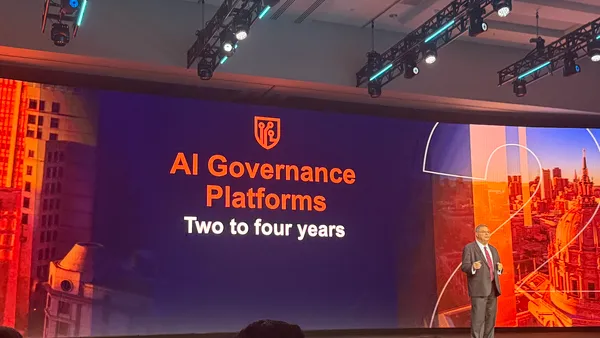For legal tech company InCloudCounsel, a vendor choice gone wrong caused hiccups amid its global expansion.
Troy Pospisil, founder and CEO, said a payments processing service provider failed to scale alongside InCloudCounsel, as the vendor couldn't distribute payments in multiple currencies.
The disruption forced the company to go back to the drawing board and figure out a new strategy. And it wasn't the only vendor to fail: finance and HR software providers also required updates.
"It was a ton of work," Pospisil told CIO Dive. "It's something that you didn't think you had to worry about."
A tough, time-consuming decision for IT leaders revolves around vendor selection, particularly as business app usage across industries expands and more processes intersect with data analytics.
Decision makers who rely on early experiences, focus on cost efficiency and ask the right questions at the right time can maximize their chances for success, avoiding the risk of wasting time and money by deploying the wrong technology.
In other words, they'll be able to get back to work.
Assess, try, buy
Seeing technology perform the way it's supposed to signals a good match between vendors and customers.
Getting a test-drive of how the product would work within the specific use case a customer needs to address helps decision makers find value, said Liz Herbert, VP and principal analyst at Forrester Research.
"Historically, what people were doing in software selection is they would have these massive spreadsheets listing off [their needs] and vendors would fill them out," said Herbert, in an interview with CIO Dive. Modern vendor selection relies on software companies proving to potential customers what outcomes they'd be able to deliver through live tests or pilot programs.
In this scenario, software vendors have their work cut out for them since companies often get approached to enter into pilot programs. In turn, smaller, more resource-constrained vendors struggle under the pilot model, since offering initial, free access to tools have become the norm in the software market.
Some execs have turned to AI to lighten the load of picking vendors and suppliers. The technology helps leaders wade through crowded markets to identify potential value.
The innovation cycle of a software product can also help tech execs determine the advantages of a software platform. If a vendor has a track record of doing several major, innovative releases per year, it can be a sign of added value for users, according to Herbert.
But evaluating a vendor also means looking at how its leaders run the business, and not just the technology they can provide. Savvy IT leaders also inquire about that company's stability, its finances and long-term goals, Pospisil said.
"Are they financially stable? Are they looking to get acquired? Or are they looking to grow a real company and really serve customers? I don't think it's inappropriate to ask these questions," Pospisil said. "I'm actually shocked how few people ask us, 'What does your balance sheet look like?'"
A vendor shopping list
Regardless of industry, decision makers should have a strategy in place to pick the tools they'll use.
Pospisil uses a shopping list of sorts to ensure the right questions are asked of vendors at the right time. Here are some key questions to ask:
- Does the firm have a dedicated solution tailored to the specific industry?
- Is the company profitable? If so, for how long?
- How long has the company been delivering this solution? How long has the management team been involved?
- What are the company's data security investments?
- Can the company easily set up several references with existing clients that are similar to the prospective customer, for the same solution?
Once IT leaders pick a tool, the work is far from over. A proper implementation strategy can help avoid further hiccups.
"In a lot of cases, it wasn't necessarily that the tool wasn't a fit," Herbert said. Instead, It's about choices made during the implementation which led to bad results.
Enterprise resource planning (ERP) software is particularly susceptible to overcustomization. When adopting the platform, customers often make many changes in response to the whole organization, which makes the platform hard to upgrade, support and maintain.
"Software selection is just one piece," Herbert said. "You can mess up a perfectly good tool through bad implementation."













